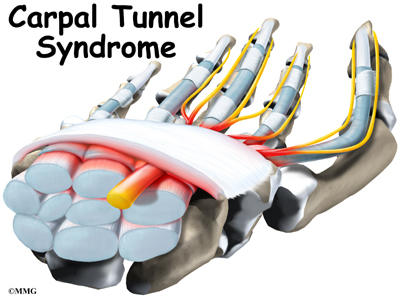by Andrew J Gaetano, PT, DPT, OCS, CSCS
Carpal Tunnel Syndrome is a very common condition in the wrist and hand that can affect daily functions at work, home, and sport. The “Carpal Tunnel” itself is a small space on the front of your wrist, about as wide as your thumb, that contains the tendons of the fingers (9 of them total) and a nerve. The problem in this syndrome is compression on that nerve that passes through the wrist on the way to the hand (the median nerve). Compression can come from narrowing of the space in the tunnel, crowding of the tendons, inflammation or injury. When you compress a nerve, it doesn’t pass the signals along to your brain properly (like stepping on a garden hose).
How can you develop Carpal Tunnel Syndrome?
Extreme wrist positions, as well as a lot of finger use (i.e typing), especially with a lot of force or vibration (such as holding the steering wheel when driving heavy machinery), can all contribute to carpal tunnel syndrome. Certain other conditions can cause this syndrome, such as diabetes, pregnancy (fluid retention leads to less space in the tunnel), or certain medications.
What do you feel when you compress the nerve in the tunnel?
It usually starts gradually, with symptoms such as burning, tingling, “pins and needles,” or numbness in the palm of the hand and fingers (the thumb, pointer, and middle finger usually). Often the symptoms are more noticeable during the night, and individuals often report being wakened with symptoms. Many people feel the need to “shake out” their hands to try to relieve the symptoms.
As the condition progresses, the symptoms are noticed during the daytime and are often worse when holding items such as a heavy book or a hairbrush. Weakness of the hand and more constant numbness may occur if the pressure on the nerve continues. You may find that you drop objects unexpectedly or have a weakness in your grip.
What do we do in physical therapy to help?
The first thing we do at Capital Area Physical Therapy is determine the source of your problem. Not all people with tingling in their hands have true “carpal tunnel syndrome”, and we will determine that for you through our evaluation. Based on what we find, will be able to to educate you on:
- changing poor wrist positions (avoiding prolonged bent wrist postures)
- proper neck and upper back posture (ie, avoiding forward head or slouching)
- “stretch breaks” during your work or daily routine- we will teach you these
- Exercises to increase the strength of the muscles in your hand, fingers, and forearm and improve your posture
- Stretching exercises to improve the flexibility of the wrist, hand, and fingers
- Use of modalities such as heat/cold, ultrasound or iontophoresis (medication delivery through electric stimulation)
Your work station and posture will most like have a relation to your problem. If this is your case, it may be beneficial to watch these Youtube videos on workstation ergonomics:
http://www.youtube.com/channel/UC8fwQyrDRmlKmw57pz_c_uA
There will also most likely be other techniques we can use to help improve your wrist motion and improve the way the nerve moves inside the carpal tunnel space.
Can you do anything to prevent this issue?
Although there isn’t one single solution to preventing or treating this problem, there are ways to minimize stress to the hands and wrists.
- Reduce force. Most people use more force than needed when performing work with their hands. Relax your grip to avoid muscle fatigue and strain. For prolonged handwriting, use a larger-handle pen or soft gel grip.
- Take frequent breaks. When doing repeated activities, give your hands a break by performing stretching exercises once in a while. If possible, alternate your hands when completing some tasks.
- Neutral wrist position. Avoid bending your wrists by keeping them in a straight or “neutral” position. This means your wrist should not be bent up (extended) or down (flexed).
- Worksite adjustments. Check out the Youtube videos above
- Improve your posture. Make sure your posture is appropriate to the task you are performing. Believe it or not, proper alignment of your trunk, neck, and shoulders can prevent excessive strain and improper positioning of the wrists and hands.
- Keep your hands warm. You are more likely to develop hand pain and stiffness if you work in a cold environment. If you can’t control the temperature, be sure to wear gloves to keep your hands and wrists warm.
Malta NY






